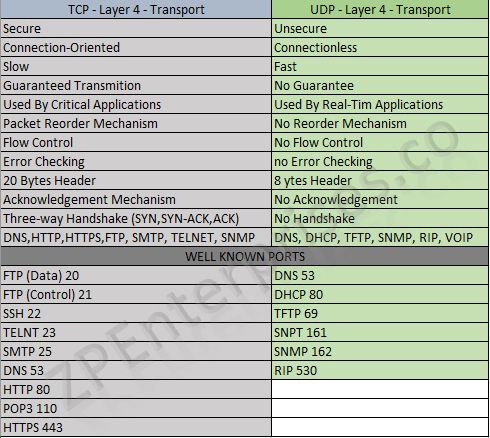Here, we will compare these two protocols’ main characteristics, and we will look at TCP Protocol (Transmission Control Protocol) and UDP Protocol (User Datagram Protocol). This comparison is very important and, generally, a question asked in Network Engineering, Cyber Security, or Infrastructure interviews. It also is important for students and security certification tets and is a simple quick list and by far is only a start.
Below, you can find a table that compares TCP vs. UDP and an abbreviated list of common ports.
TCP and UDP Application Ports

Generally, Port ranges can be divided into three. These are:
• Well-Known Ports ( 1 to 1024 )
• Registered Ports ( 1025 to 49151 )
• Private Ports ( 49152 to 65535 )
The applications which use TCP and UDP use Well-Known Ports. Let’s see some of these Well-Known Ports.
TCP Well-Known Ports
There are some applications that use TCP. Some of these applications are :
• FTP (Port 20,21)
• SSH (Port 22)
• Telnet (Port 23)
• SMTP (Port 25)
• DNS (Port 53)
• HTTP (Port 80)
• POP3 (Port 110)
• SNMP (Port 161)
• SNMP Trap (Port 162)
• HTTPS (Port 443)
UDP Well-Known Ports
Some network services use UDP and UDP Ports. Some of these services are :
• DNS (Port 53)
• DHCP (Port 67)
• TFTP (Port 69)
• SNMP (Port 161)
• SNMP Trap (Port 162)
• RIP (Port 520)
Etc.
Some of these ports can be used for both Protocols. You can find the whole list of these ports on the IANA Website.
In that list, you can also see the ports of other Trasport Layer protocols, Stream Control Transmission Protocol (SCTP), and Datagram Congestion Control Protocol (DCCP), besides UDP and TCP.
